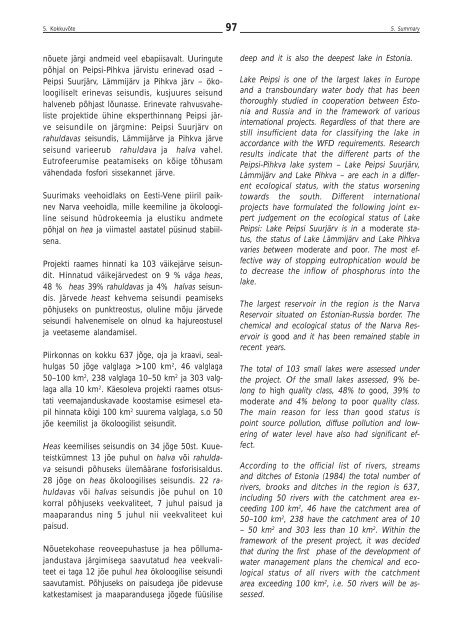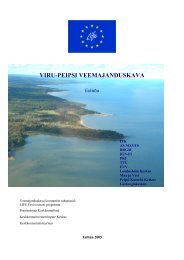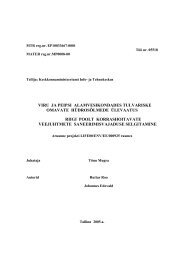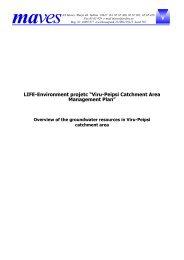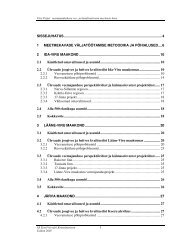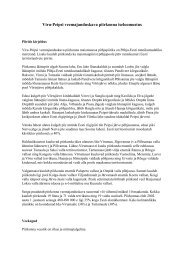Viru-Peipsi veemajanduskava - Keskkonnaministeerium
Viru-Peipsi veemajanduskava - Keskkonnaministeerium
Viru-Peipsi veemajanduskava - Keskkonnaministeerium
You also want an ePaper? Increase the reach of your titles
YUMPU automatically turns print PDFs into web optimized ePapers that Google loves.
97<br />
5. Kokkuvõte 5. Summary<br />
nõuete järgi andmeid veel ebapiisavalt. Uuringute<br />
põhjal on <strong>Peipsi</strong>-Pihkva järvistu erinevad osad –<br />
<strong>Peipsi</strong> Suurjärv, Lämmijärv ja Pihkva järv – ökoloogiliselt<br />
erinevas seisundis, kusjuures seisund<br />
halveneb põhjast lõunasse. Erinevate rahvusvaheliste<br />
projektide ühine eksperthinnang <strong>Peipsi</strong> järve<br />
seisundile on järgmine: <strong>Peipsi</strong> Suurjärv on<br />
rahuldavas seisundis, Lämmijärve ja Pihkva järve<br />
seisund varieerub rahuldava ja halva vahel.<br />
Eutrofeerumise peatamiseks on kõige tõhusam<br />
vähendada fosfori sissekannet järve.<br />
Suurimaks veehoidlaks on Eesti-Vene piiril paiknev<br />
Narva veehoidla, mille keemiline ja ökoloogiline<br />
seisund hüdrokeemia ja elustiku andmete<br />
põhjal on hea ja viimastel aastatel püsinud stabiilsena.<br />
Projekti raames hinnati ka 103 väikejärve seisundit.<br />
Hinnatud väikejärvedest on 9 % väga heas,<br />
48 % heas 39% rahuldavas ja 4% halvas seisundis.<br />
Järvede heast kehvema seisundi peamiseks<br />
põhjuseks on punktreostus, oluline mõju järvede<br />
seisundi halvenemisele on olnud ka hajureostusel<br />
ja veetaseme alandamisel.<br />
Piirkonnas on kokku 637 jõge, oja ja kraavi, sealhulgas<br />
50 jõge valglaga >100 km 2 , 46 valglaga<br />
50–100 km 2 , 238 valglaga 10–50 km 2 ja 303 valglaga<br />
alla 10 km 2 . Käesoleva projekti raames otsustati<br />
<strong>veemajanduskava</strong>de koostamise esimesel etapil<br />
hinnata kõigi 100 km 2 suurema valglaga, s.o 50<br />
jõe keemilist ja ökoloogilist seisundit.<br />
Heas keemilises seisundis on 34 jõge 50st. Kuueteistkümnest<br />
13 jõe puhul on halva või rahuldava<br />
seisundi põhuseks ülemäärane fosforisisaldus.<br />
28 jõge on heas ökoloogilises seisundis. 22 rahuldavas<br />
või halvas seisundis jõe puhul on 10<br />
korral põhjuseks veekvaliteet, 7 juhul paisud ja<br />
maaparandus ning 5 juhul nii veekvaliteet kui<br />
paisud.<br />
Nõuetekohase reoveepuhastuse ja hea põllumajandustava<br />
järgimisega saavutatud hea veekvaliteet<br />
ei taga 12 jõe puhul hea ökoloogilise seisundi<br />
saavutamist. Põhjuseks on paisudega jõe pidevuse<br />
katkestamisest ja maaparandusega jõgede füüsilise<br />
deep and it is also the deepest lake in Estonia.<br />
Lake <strong>Peipsi</strong> is one of the largest lakes in Europe<br />
and a transboundary water body that has been<br />
thoroughly studied in cooperation between Estonia<br />
and Russia and in the framework of various<br />
international projects. Regardless of that there are<br />
still insufficient data for classifying the lake in<br />
accordance with the WFD requirements. Research<br />
results indicate that the different parts of the<br />
<strong>Peipsi</strong>-Pihkva lake system – Lake <strong>Peipsi</strong> Suurjärv,<br />
Lämmijärv and Lake Pihkva – are each in a different<br />
ecological status, with the status worsening<br />
towards the south. Different international<br />
projects have formulated the following joint expert<br />
judgement on the ecological status of Lake<br />
<strong>Peipsi</strong>: Lake <strong>Peipsi</strong> Suurjärv is in a moderate status,<br />
the status of Lake Lämmijärv and Lake Pihkva<br />
varies between moderate and poor. The most effective<br />
way of stopping eutrophication would be<br />
to decrease the inflow of phosphorus into the<br />
lake.<br />
The largest reservoir in the region is the Narva<br />
Reservoir situated on Estonian-Russia border. The<br />
chemical and ecological status of the Narva Reservoir<br />
is good and it has been remained stable in<br />
recent years.<br />
The total of 103 small lakes were assessed under<br />
the project. Of the small lakes assessed, 9% belong<br />
to high quality class, 48% to good, 39% to<br />
moderate and 4% belong to poor quality class.<br />
The main reason for less than good status is<br />
point source pollution, diffuse pollution and lowering<br />
of water level have also had significant effect.<br />
According to the official list of rivers, streams<br />
and ditches of Estonia (1984) the total number of<br />
rivers, brooks and ditches in the region is 637,<br />
including 50 rivers with the catchment area exceeding<br />
100 km 2 , 46 have the catchment area of<br />
50–100 km 2 , 238 have the catchment area of 10<br />
– 50 km 2 and 303 less than 10 km 2 . Within the<br />
framework of the present project, it was decided<br />
that during the first phase of the development of<br />
water management plans the chemical and ecological<br />
status of all rivers with the catchment<br />
area exceeding 100 km 2 , i.e. 50 rivers will be assessed.


